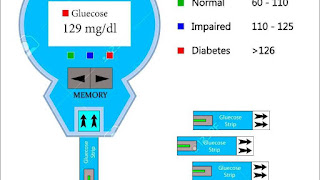Video Glucose test
Reasons for testing
A glucose test may be recommended for a variety of reasons. One may be screening for gestational diabetes during pregnancy. This form of diabetes is temporary during pregnancy, and with glucose-controlling medication or insulin symptoms can be improved.Blood glucose tests can also be used when a person is concerned about certain risks, such as, obesity, family history, high blood pressure, and heart disease. Following the test, the patient will know their body's sugar level. Blood glucose testing can also be used to test for hypoglycemia, which occurs when levels of glucose are too low.
The two main types of diabetes are Type 1 and Type 2. If diagnosed with diabetes, regulate glucose tests can help manage or maintain conditions. Type 1, is commonly seen in children or teenagers whose bodies are not producing enough insulin. Type 2 diabetes, is typically seen in adults who are overweight. The insulin in their bodies are either not working normally, or there is not being enough produced.For someone with diabetes, checking glucose levels may become a daily routine. Disposable glucose test strips are used for electrochemical determinations of blood glucose, making testing easier by using a small amount of blood.
Maps Glucose test
Preparations for testing
Before taking a glucose test, fasting for eight hours prior to testing may be required. Fasting glucose testing is commonly more accurate and will indicate if blood sugar levels are normal (5.6 mmol/L), pre-diabetic (5.6-6.9 mmol/L), or diabetic (7mmol/L). Other forms of glucose testing include random blood sugar test and oral glucose tolerance test. The random blood sugar test checks your blood glucose at any time during the day regardless of eating last. A reading of 200mg/dL or higher would indicate diabetes. With the oral glucose tolerance test, a sugary drink is consumed before blood is drawn. The glucose test is performed by inserting a small needle, usually into the vein of your arm, to collect a small sample of blood.
Glucose
Glucose is a type of sugar that is obtained in the body by eating foods with a high carbohydrate level, such as bread and potatoes. Glucose is used for energy and released into your body during digestion. Your body can process glucose by a hormone, call insulin. Insulin is made in the pancreas and aids in regulating the sugar obtained by food. When sugar levels are too high, sugar can be stored in the liver and used when sugar levels begin to fall.
At Home Glucose Testing
Another form of blood glucose test strips are visual indicators. Blood glucose strips are composed of two membranes that will cause a color change when the reagent from the membrane reacts with the blood sample. The membrane will display two different colors and the colors are compared to a calibrated color chart permits a user to determine the glucose concentration in the blood sample. Preparations for at home methods include pricking your finger to produce a small amount of blood to sample. Checking glucose levels depends on how often insulin is used, some recommend three times a day. Another way to test your glucose level is with a Continuous Glucose Monitoring System. You wear a sensor that monitors your body fluids and you wave the CGM over your sensor , bluetooth technology. It will tell you what your current glucose is and since it takes a reading every minute it graphs what your glucose is through out the day. You can enter the type of insulin you use, when eating, add the amount of carbohydrates, and track your amount of exercise. You can scan as many times a day that you want, no finger pricking needed.
Symptoms of unregulated glucose levels
If long-term abnormal glucose levels are left untreated, patients may experience neuropathy, heart disease, blindness, skin infection, dehydration, or joint pain.
There are several different kinds of glucose tests:
- Fasting blood sugar (FBS), fasting plasma glucose (FPG): 8 or 12 or 14 hours after eating
- Glucose tolerance test: continuous testing
- Postprandial glucose test (PC): 2 hours after eating
- Random glucose test
Reference ranges
Fasting blood sugar
A range of 4 to 5.5 mmol/l (70 to 99 mg/dl) before a meal is normal. Continual fasting levels of 5.5 to 7 mmol/l (101-125 mg/dl) causes concern of possible prediabetes and may be worth monitoring. 7 mmol/l (126 mg/dl) and above means a risk of diabetes.
After a 12-hour fast, a range of 3.9 to under 5.5 mmol/l (70.2 to 100 mg/dl) is normal; a level of 5.6 to under 7 mmol/l (100 to 126 mg/dl) is considered a sign of prediabetes.
Postprandial glucose
A level of < 7.8 mmol/l (140 mg/dl) 90 minutes after a meal is normal.
See also
- Glucose meter
- Hyperglycemia
- Hypoglycemia
References
Source of article : Wikipedia

